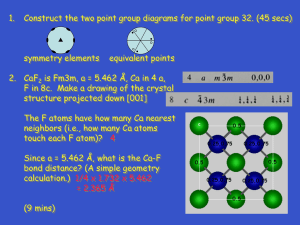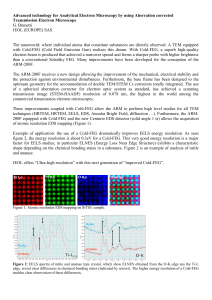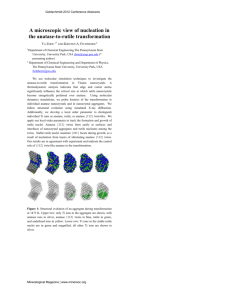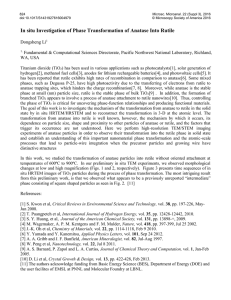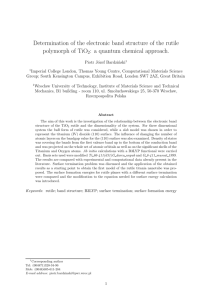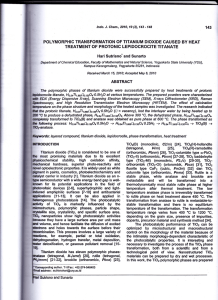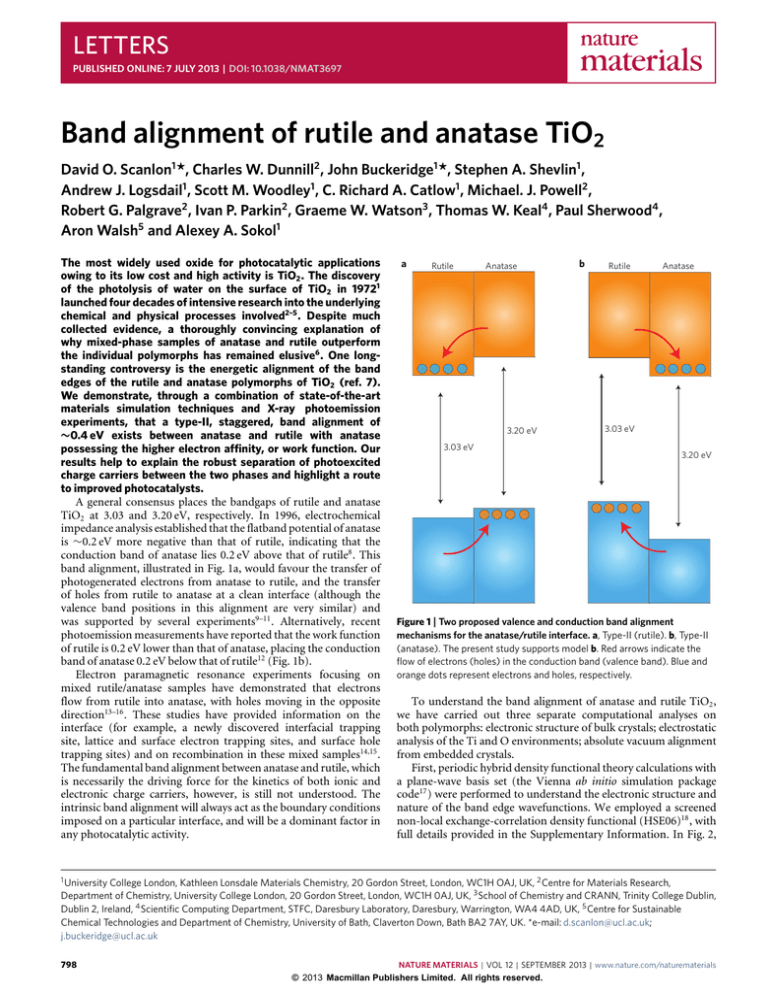
LETTERS
PUBLISHED ONLINE: 7 JULY 2013 | DOI: 10.1038/NMAT3697
Band alignment of rutile and anatase TiO2
David O. Scanlon1 *, Charles W. Dunnill2 , John Buckeridge1 *, Stephen A. Shevlin1 ,
Andrew J. Logsdail1 , Scott M. Woodley1 , C. Richard A. Catlow1 , Michael. J. Powell2 ,
Robert G. Palgrave2 , Ivan P. Parkin2 , Graeme W. Watson3 , Thomas W. Keal4 , Paul Sherwood4 ,
Aron Walsh5 and Alexey A. Sokol1
The most widely used oxide for photocatalytic applications
owing to its low cost and high activity is TiO2 . The discovery
of the photolysis of water on the surface of TiO2 in 19721
launched four decades of intensive research into the underlying
chemical and physical processes involved2–5 . Despite much
collected evidence, a thoroughly convincing explanation of
why mixed-phase samples of anatase and rutile outperform
the individual polymorphs has remained elusive6 . One longstanding controversy is the energetic alignment of the band
edges of the rutile and anatase polymorphs of TiO2 (ref. 7).
We demonstrate, through a combination of state-of-the-art
materials simulation techniques and X-ray photoemission
experiments, that a type-II, staggered, band alignment of
∼0.4 eV exists between anatase and rutile with anatase
possessing the higher electron affinity, or work function. Our
results help to explain the robust separation of photoexcited
charge carriers between the two phases and highlight a route
to improved photocatalysts.
A general consensus places the bandgaps of rutile and anatase
TiO2 at 3.03 and 3.20 eV, respectively. In 1996, electrochemical
impedance analysis established that the flatband potential of anatase
is ∼0.2 eV more negative than that of rutile, indicating that the
conduction band of anatase lies 0.2 eV above that of rutile8 . This
band alignment, illustrated in Fig. 1a, would favour the transfer of
photogenerated electrons from anatase to rutile, and the transfer
of holes from rutile to anatase at a clean interface (although the
valence band positions in this alignment are very similar) and
was supported by several experiments9–11 . Alternatively, recent
photoemission measurements have reported that the work function
of rutile is 0.2 eV lower than that of anatase, placing the conduction
band of anatase 0.2 eV below that of rutile12 (Fig. 1b).
Electron paramagnetic resonance experiments focusing on
mixed rutile/anatase samples have demonstrated that electrons
flow from rutile into anatase, with holes moving in the opposite
direction13–16 . These studies have provided information on the
interface (for example, a newly discovered interfacial trapping
site, lattice and surface electron trapping sites, and surface hole
trapping sites) and on recombination in these mixed samples14,15 .
The fundamental band alignment between anatase and rutile, which
is necessarily the driving force for the kinetics of both ionic and
electronic charge carriers, however, is still not understood. The
intrinsic band alignment will always act as the boundary conditions
imposed on a particular interface, and will be a dominant factor in
any photocatalytic activity.
a
Rutile
Anatase
3.20 eV
3.03 eV
b
Rutile
Anatase
3.03 eV
3.20 eV
Figure 1 | Two proposed valence and conduction band alignment
mechanisms for the anatase/rutile interface. a, Type-II (rutile). b, Type-II
(anatase). The present study supports model b. Red arrows indicate the
flow of electrons (holes) in the conduction band (valence band). Blue and
orange dots represent electrons and holes, respectively.
To understand the band alignment of anatase and rutile TiO2 ,
we have carried out three separate computational analyses on
both polymorphs: electronic structure of bulk crystals; electrostatic
analysis of the Ti and O environments; absolute vacuum alignment
from embedded crystals.
First, periodic hybrid density functional theory calculations with
a plane-wave basis set (the Vienna ab initio simulation package
code17 ) were performed to understand the electronic structure and
nature of the band edge wavefunctions. We employed a screened
non-local exchange-correlation density functional (HSE06)18 , with
full details provided in the Supplementary Information. In Fig. 2,
1 University
College London, Kathleen Lonsdale Materials Chemistry, 20 Gordon Street, London, WC1H OAJ, UK, 2 Centre for Materials Research,
Department of Chemistry, University College London, 20 Gordon Street, London, WC1H 0AJ, UK, 3 School of Chemistry and CRANN, Trinity College Dublin,
Dublin 2, Ireland, 4 Scientific Computing Department, STFC, Daresbury Laboratory, Daresbury, Warrington, WA4 4AD, UK, 5 Centre for Sustainable
Chemical Technologies and Department of Chemistry, University of Bath, Claverton Down, Bath BA2 7AY, UK. *e-mail: d.scanlon@ucl.ac.uk;
j.buckeridge@ucl.ac.uk
798
NATURE MATERIALS | VOL 12 | SEPTEMBER 2013 | www.nature.com/naturematerials
© 2013 Macmillan Publishers Limited. All rights reserved.
NATURE MATERIALS DOI: 10.1038/NMAT3697
a
LETTERS
we show the electronic density of states for rutile and anatase. The
valence band edge of both materials is dominated by O 2p, and
the conduction band edge is formed from Ti 3d. The widths of
the upper valence bands are similar in each phase, which indicates
that neither anatase nor rutile experience a significant chemical
broadening that could offset the valence band edge position.
Therefore, the position of the conduction and valence bands of
ionic materials such as TiO2 is determined by the onsite electrostatic
potential and the optical dielectric response.
The analysis in Fig. 2 illustrates that excess electrons in these
materials will be centred on the d states of cations, whereas electron
holes are centred on 2p states of oxygen, which is consistent
with electron paramagnetic resonance data. We have calculated
the local Madelung potentials19 of Ti and O in both anatase and
rutile using the polarizable shell model20,21 , fitted to reproduce
accurately the high-frequency dielectric constants of TiO2 . Note
that negatively charged electrons have a lower energy the higher
the Madelung potential (cation sites have a negative potential)
whereas the energy to create a positive hole is lower, the lower
the Madelung energy (anion sites have a positive potential). This
analysis indicates that the Madelung potential of Ti in anatase
(−45.025 V) is 0.17 eV higher than the potential of Ti in rutile
(−45.199 V). The offset is in excellent agreement with recent
photoemission measurements. Similarly, the Madelung potential of
O in anatase (26.232 V) is higher than the Madelung potential of
O in rutile (25.767 V), placing the valence band of rutile 0.47 eV
above the valence band of anatase, in agreement with the alignment
shown in Fig. 1b. In support of this fundamental argument, we
have calculated energies of charge carriers propagating at the band
edges using the Mott–Littleton defect approach, which includes
the high-frequency dielectric response of the material22 . The
calculated difference in carrier energies between the two materials
strongly corroborates the band alignment put forward above. In
particular, for the electrons at the bottom of the conduction band
we obtain a 0.24 eV shift downwards of the anatase conduction
band relative to rutile, whereas for the hole carrier we find the
valence band of rutile to be 0.39 eV higher in energy than that of
anatase. Both the Madelung-potential-based argument and ‘defect’
models predicted correctly the bandgap opening of ∼0.2 eV in
anatase relative to rutile.
Last, we have calculated the ionization potentials of both
polymorphs relative to the vacuum level using a hybrid
quantum-mechanical/molecular-mechanical23 (QM/MM) embedding technique as implemented in the ChemShell code24 . In this
approach, a part of the crystal is represented by a molecular cluster
(treated at a QM level of theory) embedded in an external potential,
which represents the system remainder (treated at an MM level of
theory), as illustrated in Fig. 3a. Exploiting the accurate account
of electronic polarization by the MM model introduced above, we
are able to calculate the system response to ionization, on which
all electronic degrees of freedom are fully relaxed while keeping the
nuclei frozen. The ionization potential is calculated by taking the
energy difference between a (electronically) relaxed system in the
neutral and positive charge states (see Supplementary Information
for details). We have calculated the ionization potential of both
rutile and anatase for a series of QM cluster sizes (from ∼50
atoms to ∼80 atoms), using a well-converged basis set. The model
consistently predicts an offset of ∼0.47 eV between rutile and
anatase, with the rutile valence band higher in energy than anatase,
as indicated in Fig. 3b.
The calculations place the ionization potential of rutile at
7.83 eV, with the ionization potential of anatase at 8.30 eV. Previous
studies have assumed that the ionization potential of rutile is
7.1 eV (ref. 25), although this is inferred from the conduction
band position taken from ref. 8. The accuracy of our approach
is supported by comparison with a recent X-ray photoelectron
spectroscopy (XPS) alignment of rutile TiO2 with ZnO, which
found that the valence band of rutile is 0.14 eV lower22 . The
experimental ionization potential of ZnO is known to be 7.82 eV,
(ref. 26) and is well described by the QM/MM approach (7.71 eV;
ref. 27). Indeed, the offset between the calculated ionization
potentials for rutile and ZnO (0.12 eV) is in excellent agreement
with the experimental offset of 0.14 eV. In addition, our calculated
electron affinities for rutile (4.8 eV) and anatase (5.1 eV) are
in good agreement with those experimentally measured, that is
4.9 eV for rutile, 5.1 eV for anatase12 . The effective bandgap for a
clean rutile/anatase heterojunction should therefore be lowered to
∼2.78 eV, a significant redshift from the isolated phases.
To test the model band alignment, we have fabricated highquality anatase–rutile junctions. Nanoparticulate heterostructures
were achieved using a sol–gel approach from a titanium n-butoxide
precursor. A uniform interface was formed by dip-coating
successive layers onto a NaCl substrate; first rutile (700 ◦ C anneal)
and later anatase (500 ◦ C anneal). The original substrate was then
dissolved in water, leaving a freestanding rutile–anatase bilayer. For
full details of the synthesis and characterization of these materials,
see the Supplementary Information. High-resolution XPS was used
to determine the band offsets based on core level shifts, following
the method of refs 28–30. The binding energy difference between
the Ti 2p3/2 core line and the valence band was first determined in
samples of phase-pure anatase and rutile. In each case the core lines
for the phase-pure samples were fitted with a Gaussian–Lorentzian
function. These same functions were used to peak fit the Ti 2p3/2
spectrum obtained from the composite particles, and so obtain
the binding energies (Fig. 3c), and hence the valence band offsets
(Fig. 3d). To aid this peak fitting, samples were produced with a 2:1,
1:1 and 1:2 ratio of rutile to anatase. Full details of this procedure
are given in the Supplementary Information. The anatase valence
band was found to be at 0.39 ± 0.02 eV higher binding energy
than rutile for the composite samples. These results were obtained
independently of the computational analysis.
In conclusion, we have combined theory and experiment to
revise the understanding of the band alignment between rutile
and anatase. A consistent picture emerged, where in contrast to
the widely accepted alignment model, we demonstrate that the
electron affinity of anatase is higher than rutile. Photogenerated
NATURE MATERIALS | VOL 12 | SEPTEMBER 2013 | www.nature.com/naturematerials
799
Anatase
Total DOS
Op
Ti s
¬7
b
¬6
Ti d
Ti p
¬5
¬4
¬3
¬2
¬1
0
Energy (eV)
1
2
3
4
5
Rutile
Total DOS
Op
Ti s
¬7
¬6
Ti d
Ti p
¬5
¬4
¬3
¬2
¬1
0
Energy (eV)
1
2
3
4
5
Figure 2 | Electronic structure of anatase and rutile TiO2 . a,b, Comparison
of the total and ion-decomposed electronic density of states of anatase (a)
and rutile (b) TiO2 calculated using the HSE06 hybrid density functional.
© 2013 Macmillan Publishers Limited. All rights reserved.
NATURE MATERIALS DOI: 10.1038/NMAT3697
LETTERS
a
b
QM/MM alignment
Vacuum level
MM frozen MM active
Energy (eV)
0
QM region
Interface
EArutile = 4.80 eV
¬4
CBM
Erutile
VBM
¬8 Erutile
CBM
Eanatase
ΔEC = 0.30 eV
IPrutile = 7.83 eV
¬6
EAanatase = 5.10 eV
IPanatase = 8.30 eV
ΔEV = 0.47 eV
Rutile
d
Intensity
c
Experiment
Exper nt
XPS alignment
Intensity
Intensity
ΔEC = 0.22 eV
CBM
Erutile
Rutile
461
Anatase
3.03 eV
Rutile
VBM
Eanatase
VBM
Erutile
3.20 eV
ΔEV = 0.39 eV
456.14 eV
456.19 eV
Anatase
Anatase
460
459
458
Binding energy (eV)
Ti
E2p
457
456
ΔECL = 0.44 eV
Rutile
Anatase
Ti
E2p
Figure 3 | Band alignment between rutile and anatase from XPS and QM/MM. a, Graphic of the hybrid QM/MM cluster used for rutile in the positive
charge state. The cluster is divided into hemispheres to highlight the different regions in the model. Hole density iso-surfaces are shown (semi-transparent
purple) in the QM region. b, Schematic of the QM/MM alignment of rutile and anatase TiO2 . IP and EA denote ionization potential and electron affinity,
respectively. The electron affinity is calculated by adding the experimental bandgaps to the calculated ionization potentials. 1EV and 1EC are the valence
band offsets and conduction band offsets, respectively and ECBM and EVBM denote the positions of the conduction band and valence band respectively. c, Ti
2p3/2 spectra are taken from two phase composite particles with rutile to anatase ratios of 1:1 (top) and 2:1 (middle) and 1:2 (bottom). Experimental data,
shown as black dots, are fitted with the peak shapes derived from phase-pure anatase (red) and rutile (blue). d, Schematic of the XPS alignment between
rutile and anatase. 1ECL is the core level offset between the Ti 2p3/2 core levels.
conduction electrons will flow from rutile to anatase. A type II band
alignment of ∼0.4 eV is present, significantly lowering the effective
bandgap of composite materials, and facilitating efficient electron–
hole separation. This alignment is the likely driving force for the
increased photoactivity of anatase–rutile composite materials over
their individual counterparts.
Despite having the same chemical composition, the differences
in the coordination environments, and hence chemical bonding,
of rutile- and anatase- structured TiO2 result in very different
ionization potentials and electron affinities. Exploitation of the
relationship between the electron chemical potentials and crystal
structure could be used to design new photoactive materials and
composites, especially where there are a number of accessible
polytypes or interfacial morphologies. This should lead towards
both higher efficiencies in the photolysis of water and more robust
electron–hole separation in dye-sensitized solar cells.
Received 25 January 2013; accepted 23 May 2013;
published online 7 July 2013
References
1. Fujishima, A. & Honda, K. Electrochemical photolysis of water at a
semiconductor electrode. Nature 238, 37–38 (1972).
800
2. Dunnill, C. W. et al. Nanoparticulate silver coated-titania thin
films-Photo-oxidative destruction of stearic acid under different light
sources and antimicrobial effects under hospital lighting conditions.
J. Photochem. Photobiol. A 220, 113–123 (2011).
3. Gratzel, M. Photoelectrochemical cells. Nature 414, 338–344 (2001).
4. Khan, S. U. M., Al-Shahry, M. & Ingler, W. B. Efficient photochemical water
splitting by a chemically modified n-TiO2 . Science 297, 2243–2245 (2002).
5. Yang, H. G. et al. Anatase TiO2 single crystals with a large percentage of reactive
facets. Nature 453, 638–641 (2008).
6. Li, G. H. & Gray, K. A. The solid-solid interface: Explaining the high and
unique photocatalytic reactivity of TiO2 -based nanocomposite materials.
Chem. Phys. 339, 173–187 (2007).
7. Deak, P., Aradi, B. & Frauenheim, T. Band lineup and charge carrier separation
in mixed rutile-anatase systems. J. Phys. Chem. C 115, 3443–3446 (2011).
8. Kavan, L., Gratzel, M., Gilbert, S. E., Klemenz, C. & Scheel, H. J. Electrochemical
and photoelectrochemical investigation of single-crystal anatase. J. Am. Chem.
Soc. 118, 6716–6723 (1996).
9. Kawahara, T. et al. A patterned TiO2 (anatase)/TiO2 (rutile) bilayer-type
photocatalyst: Effect of the anatase/rutile junction on the photocatalytic
activity. Angew. Chem. Int. Ed. 41, 2811–2813 (2002).
10. Miyagi, T., Kamei, M., Mitsuhashi, T., Ishigaki, T. & Yamazaki, A. Charge
separation at the rutile/anatase interface: A dominant factor of photocatalytic
activity. Chem. Phys. Lett. 390, 399–402 (2004).
11. Nakajima, H., Mori, T., Shen, Q. & Toyoda, T. Photoluminescence study of
mixtures of anatase and rutile TiO2 nanoparticles: Influence of charge transfer
between the nanoparticles on their photo luminescence excitation bands.
Chem. Phys. Lett. 409, 81–84 (2005).
NATURE MATERIALS | VOL 12 | SEPTEMBER 2013 | www.nature.com/naturematerials
© 2013 Macmillan Publishers Limited. All rights reserved.
NATURE MATERIALS DOI: 10.1038/NMAT3697
12. Xiong, G. et al. Photoemission electron microscopy of TiO2 anatase
films embedded with rutile nanocrystals. Adv. Funct. Mater 17,
2133–2138 (2007).
13. Hurum, D. C. et al. Probing reaction mechanisms in mixed phase TiO2 by EPR.
J. Electron Spectrosc. 150, 155–163 (2006).
14. Hurum, D. C., Agrios, A. G., Gray, K. A., Rajh, T. & Thurnauer, M. C.
Explaining the enhanced photocatalytic activity of Degussa P25 mixed-phase
TiO2 using EPR. J. Phys. Chem. B 107, 4545–4549 (2003).
15. Hurum, D. C., Gray, K. A., Rajh, T. & Thurnauer, M. C. Recombination
pathways in the Degussa P25 formulation of TiO2 : Surface versus lattice
mechanisms. J. Phys. Chem. B 109, 977–980 (2005).
16. Leytner, S. & Hupp, J. T. Evaluation of the energetics of electron trap
states at the nanocrystalline titanium dioxide/aqueous solution interface
via time-resolved photoacoustic spectroscopy. Chem. Phys. Lett. 330,
231–236 (2000).
17. Kresse, G. & Hafner, J. Ab-initio molecular-dynamics simulation of the
liquid-metal amorphous-semiconductor transition in germanium. Phys. Rev. B
49, 14251–14269 (1994).
18. Krukau, A. V., Vydrov, O. A., Izmaylov, A. F. & Scuseria, G. E. Influence of
the exchange screening parameter on the performance of screened hybrid
functionals. J. Chem. Phys. 125, 224106 (2006).
19. Madelung, E. The electric field in systems of regularly arranged point charges.
Phys. Z 19, 524–533 (1918).
20. Dick, B. G. & Overhauser, A. W. Theory of the dielectric constants of alkali
halide crystals. Phys. Rev. 112, 90–103 (1958).
21. Catlow, C. R. A. et al. Advances in computational studies of energy materials.
Philos. Trans. R. Soc. A-Math. Phys. Eng. Sci. 368, 3379–3456 (2010).
22. Wang, J. et al. Measurement of wurtzite ZnO/rutile TiO2 heterojunction
band offsets by X-ray photoelectron spectroscopy. Appl. Phys. A 103,
1099–1103 (2011).
23. Sokol, A. A., Bromley, S. T., French, S. A., Catlow, C. R. A. & Sherwood, P.
Hybrid QM/MM embedding approach for the treatment of localized surface
states in ionic materials. Int. J. Quantum Chem. 99, 695–712 (2004).
24. Sherwood, P. et al. QUASI: A general purpose implementation of the QM/MM
approach and its application to problems in catalysis. J. Mol. Struct.-Theochem.
632, 1–28 (2003).
25. Cheng, J. & Sprik, M. Aligning electronic energy levels at the TiO2 /H2 O
interface. Phys. Rev. B 82, 081406 (2010).
26. Swank, R. K. Surface properties of 2–6 compounds. Phys. Rev. 153,
844–849 (1967).
27. Sokol, A. A. et al. Point defects in ZnO. Faraday Discuss. 134, 267–282 (2007).
LETTERS
28. Grant, R. W., Kraut, E. A., Kowalczyk, S. P. & Waldrop, J. R. Measurement
of potential at semiconductor interfaces by electron-spectroscopy. J. Vac. Sci.
Technol. B 1, 320–327 (1983).
29. Kraut, E. A., Grant, R. W., Waldrop, J. R. & Kowalczyk, S. P. Semiconductor
core-level to valence-band maximum binding-energy differences—precise
determination by X-ray photoelectron-spectroscopy. Phys. Rev. B 28,
1965–1977 (1983).
30. Waldrop, J. R., Kowalczyk, S. P., Grant, R. W., Kraut, E. A. & Miller, D. L.
XPS measurement of GaAs-AlAs heterojunction band discontinuities—growth
sequence dependence. J. Vac. Sci. Technol. 19, 573–575 (1981).
Acknowledgements
The work presented here made use of the UCL Legion HPC Facility, the IRIDIS cluster
provided by the EPSRC-funded Centre for Innovation (EP/K000144/1 and
EP/K000136/1), and the HECToR supercomputer through our membership of the UK’s
HPC Materials Chemistry Consortium, which is funded by EPSRC grant EP/F067496.
The work in Dublin was supported by SFI through the PI programme (PI grant numbers
06/IN.1/I92 and 06/IN.1/I92/EC07), and made use of the Kelvin supercomputer as
maintained by TCHPC. A.W. acknowledges support from the Royal Society for a
University Research Fellowship and EU-FP7 under grant agreement 316494. D.O.S. and
C.W.D. are grateful to the Ramsay Memorial Trust and University College London for
the provision of their Ramsay Fellowships. D.O.S., R.G.P. and A.W. acknowledge
membership of the Materials Design Network.
Author contributions
D.O.S. wrote the manuscript with input from A.W. and A.A.S. D.O.S. and A.A.S.
designed the computational experiments. C.W.D., M.J.P., R.G.P. and I.P.P. designed
and performed the sample growth and XPS experiments. A.A.S., S.M.W. and C.R.A.C.
calculated and analysed the band offsets using the method of interatomic potentials,
D.O.S., S.A.S. and G.W.W. performed and analysed the periodic DFT calculations, and
J.B., A.J.L., A.A.S., T.W.K. and P.S. developed, performed and analysed the QM/MM
alignments. All authors contributed to the scientific discussion and edited the manuscript.
Additional information
Supplementary information is available in the online version of the paper. Reprints and
permissions information is available online at www.nature.com/reprints.
Correspondence and requests for materials should be addressed to D.O.S. or J.B.
Competing financial interests
The authors declare no competing financial interests.
NATURE MATERIALS | VOL 12 | SEPTEMBER 2013 | www.nature.com/naturematerials
© 2013 Macmillan Publishers Limited. All rights reserved.
801

